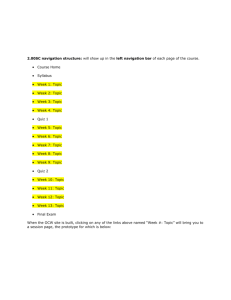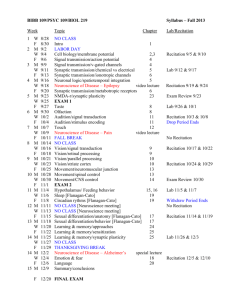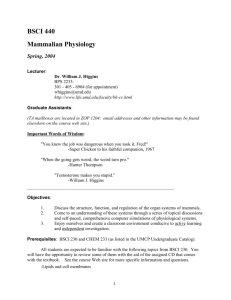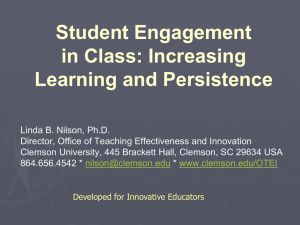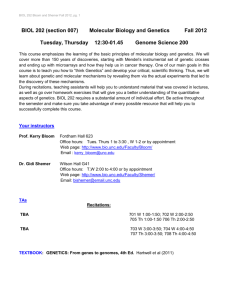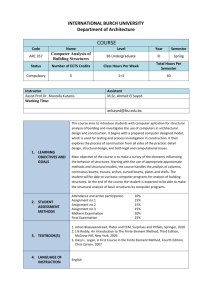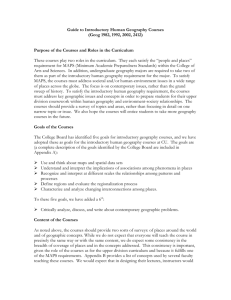2-page proposal file
advertisement
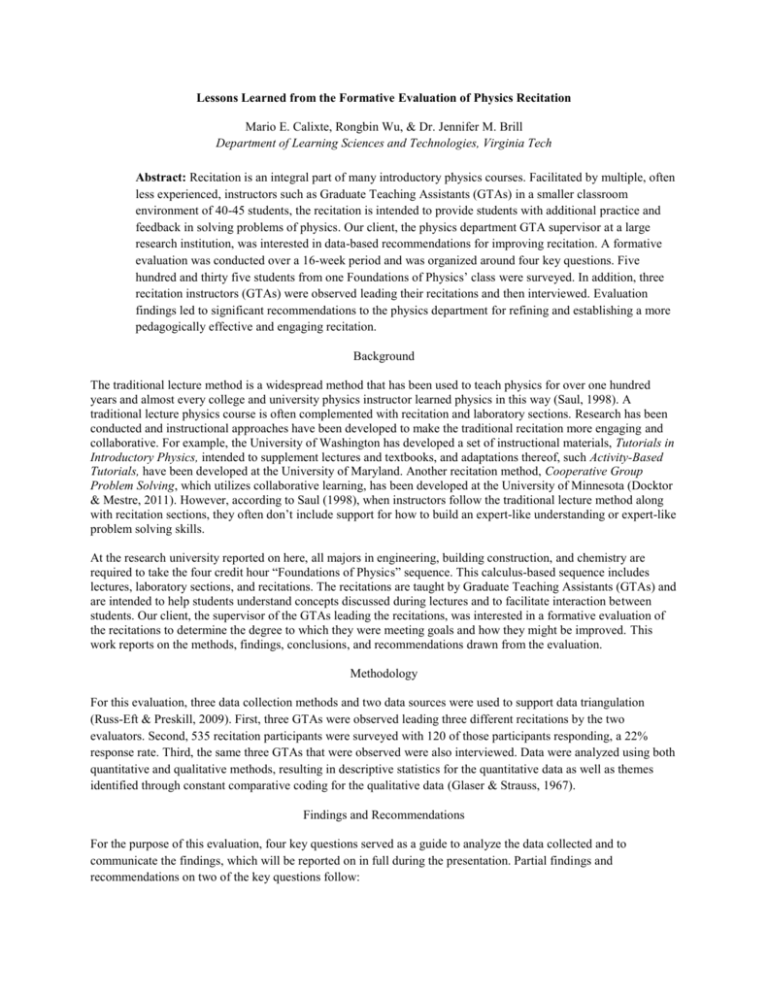
Lessons Learned from the Formative Evaluation of Physics Recitation Mario E. Calixte, Rongbin Wu, & Dr. Jennifer M. Brill Department of Learning Sciences and Technologies, Virginia Tech Abstract: Recitation is an integral part of many introductory physics courses. Facilitated by multiple, often less experienced, instructors such as Graduate Teaching Assistants (GTAs) in a smaller classroom environment of 40-45 students, the recitation is intended to provide students with additional practice and feedback in solving problems of physics. Our client, the physics department GTA supervisor at a large research institution, was interested in data-based recommendations for improving recitation. A formative evaluation was conducted over a 16-week period and was organized around four key questions. Five hundred and thirty five students from one Foundations of Physics’ class were surveyed. In addition, three recitation instructors (GTAs) were observed leading their recitations and then interviewed. Evaluation findings led to significant recommendations to the physics department for refining and establishing a more pedagogically effective and engaging recitation. Background The traditional lecture method is a widespread method that has been used to teach physics for over one hundred years and almost every college and university physics instructor learned physics in this way (Saul, 1998). A traditional lecture physics course is often complemented with recitation and laboratory sections. Research has been conducted and instructional approaches have been developed to make the traditional recitation more engaging and collaborative. For example, the University of Washington has developed a set of instructional materials, Tutorials in Introductory Physics, intended to supplement lectures and textbooks, and adaptations thereof, such Activity-Based Tutorials, have been developed at the University of Maryland. Another recitation method, Cooperative Group Problem Solving, which utilizes collaborative learning, has been developed at the University of Minnesota (Docktor & Mestre, 2011). However, according to Saul (1998), when instructors follow the traditional lecture method along with recitation sections, they often don’t include support for how to build an expert-like understanding or expert-like problem solving skills. At the research university reported on here, all majors in engineering, building construction, and chemistry are required to take the four credit hour “Foundations of Physics” sequence. This calculus-based sequence includes lectures, laboratory sections, and recitations. The recitations are taught by Graduate Teaching Assistants (GTAs) and are intended to help students understand concepts discussed during lectures and to facilitate interaction between students. Our client, the supervisor of the GTAs leading the recitations, was interested in a formative evaluation of the recitations to determine the degree to which they were meeting goals and how they might be improved. This work reports on the methods, findings, conclusions, and recommendations drawn from the evaluation. Methodology For this evaluation, three data collection methods and two data sources were used to support data triangulation (Russ-Eft & Preskill, 2009). First, three GTAs were observed leading three different recitations by the two evaluators. Second, 535 recitation participants were surveyed with 120 of those participants responding, a 22% response rate. Third, the same three GTAs that were observed were also interviewed. Data were analyzed using both quantitative and qualitative methods, resulting in descriptive statistics for the quantitative data as well as themes identified through constant comparative coding for the qualitative data (Glaser & Strauss, 1967). Findings and Recommendations For the purpose of this evaluation, four key questions served as a guide to analyze the data collected and to communicate the findings, which will be reported on in full during the presentation. Partial findings and recommendations on two of the key questions follow: What is the purpose of the recitation sessions? Of the 120 participants that completed the survey, 78 responded to this question. Some of the responses provided by the participants are coherent and have some similarities, while others are very different and inconsistent. The variation in responses suggested that students were not well informed of the purpose of the recitation. Unclear or uncommunicated goals can negatively impact learning (Gagne, Briggs, Wager, 1992). Thus, we recommended that students should be explicitly informed of the goals of the recitation so that they can understand where they are headed and be prepared to use their time productively. While 67% of students agreed or strongly agreed that the recitations help them to clarify ideas and concepts from the text and lectures, perhaps this percentage could be increased if recitation sessions were connected explicitly to learning goals common to all three learning resources. How are the recitation sessions organized? The recitation sessions are held once a week for 50 minutes. Each week, the GTA Supervisor creates a problem worksheet that is distributed to the students prior to the recitations. Students have the option of solving the problem(s) at home, turning in their work at the beginning of the recitation, and then leaving. Or, students can work in groups to solve the problem(s), asking questions as they proceed. Opportunities for such practice and feedback, including peer feedback, are vital to developing knowledge, skills, and expertise (Brill & Hodges, 2011; Gagne, Briggs, & Wager, 1992). Thus, we recommended that recitation instructors formalize and require a cooperative group learning strategy during recitations. We also recommended the inclusion of an explicit problem-solving strategy such as one influenced by the work of Reif (2008) or Shoenfeld (1994). Conclusion This evaluation project provided the opportunity for the GTA supervisor and GTAs to understand more clearly how the Foundation of Physics recitation was currently operating and being perceived by students and how it could be improved upon. Recitation, as one of the common elements of the traditional structure of Foundations of Physics, can play a greater role in student learning with the consistent integration of such important instructional elements as explicit goals, collaborative practice and feedback, and problem-solving strategies. Data-based decision-making processes, such as formative evaluation, can guide the way to targeted improvements. References Brill, J.M., & Hodges, C.B. (2011). Investigating peer review as an intentional learning strategy to foster collaborative knowledge-building in students of instructional design. International Journal of Teaching and Learning in Higher Education.23(1), 114-118. Docktor , J.L., & Mestre, J.P. (2011). A synthesis of discipline-based education research in physics. Retrieved from http://www7.nationalacademies.org/bose/DBER_Docktor_October_Paper.pdf. Gagne, R., Briggs, L., & Wagner, W. (1992). Principles of instructional design. Fort Worth: Harcourt Brace Jovanovich. Glaser, B.G., & Strauss, A.L. (1967) The discovery of grounded theory: Strategies for qualitative research. Chicago: Aldine. Reif, F. (2008). Applying cognitive science to education: Thinking and learning in scientific and other complex domains. Cambridge, MA: MIT Press. Russ-Eft, D., & Preskill, H. (2009). Evaluation in organizations: A systematic approach to enhancing learning, performance, and change. New York, NY: Basic Books. Saul, J.M. (1998). Beyond problem solving: Evaluating introductory physics courses through the hidden curriculum. Ph.D. Dissertation, University of Maryland. Schoenfield, A.H. (Ed.). (1994) Mathematical thinking and problem solving. Hillsdale, NJ: Lawrence Erlbaum.


